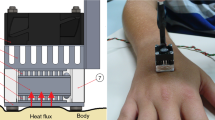Abstract
The purpose of the calorimetric sensor developed is to measure the heat flux transmitted by conduction between the human body surface and a thermostat located inside the sensor. The measurement surface has an area of 2 × 2 cm2. We have verified that the measured heat flux decreases linearly with the increase in the thermostat temperature. This allows us to define an equivalent thermal resistance between the internal temperature of the human body and the temperature of the thermostat. This equivalent thermal resistance can be determined by measuring the heat flux for different constant temperatures of the thermostat. An alternative is to perform a single measurement with linear programming of the thermostat temperature. With this type of measurement and from the calorimetric signal, it is also possible to determine an equivalent heat capacity of the skin in the measurement zone. In this article, we present the modelling and simulation of the sensor operation when the thermostat temperature varies linearly. We also present experimental measurements performed on the human body and with reference Joule dissipations.










Similar content being viewed by others
References
Socorro F. Rodríguez de Rivera M (2010) Development of a calorimetric sensor for medical application. Part I. Operating model. J Therm Anal Calorim. 2010;99:799–802.
Jesús Ch, Socorro F, Rodríguez de Rivera M. Development of a calorimetric sensor for medical application. Part II. Identification and simulation. J Therm Anal Calorim. 2013;113:1003–7.
Jesús Ch, Socorro F, Rodríguez de Rivera M. Development of a calorimetric sensor for medical application. Part III. Operating methods and applications. J Therm Anal Calorim. 2013;113:1009–13.
Jesús Ch, Socorro F, Rodríguez de Rivera HJ, Rodriguez de Rivera M. Development of a calorimetric sensor for medical application. Part IV. Deconvolution of the calorimetric signal. J Therm Anal Calorim. 2014;116:151–5.
Socorro F, Rodríguez de Rivera PJ, Rodríguez de Rivera M. Calorimetric minisensor for the localized measurement of surface heat dissipated from the human body. Sensors. 2016;16:1864.
Socorro F, Rodríguez de Rivera PJ, de Rivera Rodríguez, Mi Rodríguez, de Rivera M. Mathematical model for localised and surface heat flux of the human body obtained from measurements performed with a calorimetry minisensor. Sensors. 2017;17:2749.
Rodríguez de Rivera PJ, de Rivera Rodríguez, Mi Socorro F, Rodríguez de Rivera M. Method for transient heat flux determination in human body surface using a direct calorimetry sensor. Measurement. 2019;39:1–9.
Rodríguez de Rivera PJ, de Rivera Rodríguez, Mi Socorro F, Rodríguez de Rivera M. Measurement of human body surface heat flux using a calorimetric sensor. J Therm Biol. 2019;81:178–84.
Hansen LD. Toward a standard nomenclature for calorimetry. Thermochim Acta. 2001;371:19–22.
Lahiri BB, Bagavathiaappan S, Jayakumar T, Philip J. Medical applications of infrared thermography: a review. Infrared Phys Technol. 2012;55:221–35.
Livingston S, Nolan R, Frim J, Reed L, Limmer R. A thermographic study of the effect of body composition and ambient temperature on the accuracy of mean skin temperature calculations. Eur J Appl Physiol Occup Physiol. 1987;56:120–5.
Dębiec-Bąk A, Kuligowski T, Skrzek A. Analyzing thermoregulation processes in early school-age girls and boys through thermography. J Therm Anal Calorim. 2019. https://doi.org/10.1007/s10973-019-08843-z.
Kasprzyk T, Cholewka A, Kucewicz M, Sieron K, Sillero-Quintana M, Morawiec T, Stanek A. A quantitative thermal analysis of cyclists’ thermo-active base layers. J Therm Anal Calorim. 2019;136:1689–99.
Godoy SE, Hayat MM, Ramirez DA, Myers SA, Padilla RS, Krishna S. Detection theory for accurate and non-invasive skin cancer diagnosis using dynamic thermal imaging. Biomed Opt Express. 2017;8(4):2301–23.
Nowak I, Mraz M, Mraz M. Thermography assessment of spastic lower limb in patients after cerebral stroke undergoing rehabilitation. J Therm Anal Calorim. 2019. https://doi.org/10.1007/s10973-019-08844-y.
Kasprzyk-Kucewicz T, Cholewka A, Bałamut K, Kownacki P, Kaszuba N, Kaszuba M, Stanek A, Sieroń K, Stransky J, Pasz A, Morawiec T. The applications of infrared thermography in surgical removal of retained teeth effects assessment. J Therm Anal Calorim. 2020. https://doi.org/10.1007/s10973-020-09457-6.
Isalgue A, Ortin J, Torra V, Viñals J. Heat flux calorimeters: dynamical model localized time constants. An Fis. 1980;76:192–6.
Socorro F, de Rivera MR, Jesús Ch. A thermal model of a flow calorimeter. J Therm Anal Calorim. 2001;64:357–66.
Socorro F, de la Nuez I, Rodríguez de Rivera M. Calibration of isothermal heat conduction calorimeters: case of flow calorimeters. Measurement. 2003;33:241–50.
Kirchner R, de Rivera MR, Seidel JM, Torra V. Identification of micro-scale calorimetric devices. Part VI. An approach by RC-representative model to improvements in TAM microcalorimeters. J Therm Anal Calorim. 2005;82:179–84.
Lagarias JC, Reeds JA, Wright MH, Wright PE. Convergence properties of the Nelder–Mead simplex method in low dimensions. SIAM J Opt. 1998;9(1):112–47.
Nelder JA, Mead C. A simplex method for function minimization. Comput J. 1965;7:308–13.
Optimization ToolboxTM User’s Guide (2004) 5th printing; Revised for Version 3.0 (Release 14); The MathWorks, Inc.: Natic, MA, USA.
Acknowledgements
The authors would like to acknowledge Professor J.A. López Calbet for his help in the experimental measurements performed in “Laboratorio de Rendimiento Humano de la Universidad de Las Palmas de Gran Canaria”.
Funding
This work was completed while Pedro Jesús Rodríguez de Rivera was beneficiary of a pre-doctoral grant given by the “Ministerio de Ciencia, Innovación y Universidades (Spain)” (No. FPU18/02990) and the “Agencia Canaria de Investigación, Innovación y Sociedad de la Información del Gobierno de Canarias (Spain)” (No. TESIS2019010023).
Author information
Authors and Affiliations
Corresponding author
Additional information
Publisher's Note
Springer Nature remains neutral with regard to jurisdictional claims in published maps and institutional affiliations.
Rights and permissions
About this article
Cite this article
Rodríguez de Rivera, P.J., Rodríguez de Rivera, M., Socorro, F. et al. Human skin thermal properties determination using a calorimetric sensor. J Therm Anal Calorim 142, 461–471 (2020). https://doi.org/10.1007/s10973-020-09627-6
Received:
Accepted:
Published:
Issue Date:
DOI: https://doi.org/10.1007/s10973-020-09627-6




